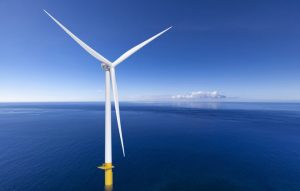A single rotation of the first turbine’s 107m long Haliade-X blades can produce enough clean energy to power an average home for two days.
Built on an isolated sandbank 130km out in the North Sea, Dogger Bank Wind Farm is the largest wind power development in the world. Work first began back in 2010, and Dogger Bank A began generating power in October 2023. When complete, the Dogger Bank development will deliver clean energy to six million homes every year.
In Sept 2024 SSE Renewables invited members of the public to have their say on the proposed fourth phase of the wind farm, Dogger Bank D. It would be located in the North Sea, around 130 miles off the Yorkshire coast and be capable of generating up to 2GW of renewable power. The first three phases will have already introduced 630 turbines standing 623 ft (190m) high, built by Siemens in Hull
An astonishing fact is that a single rotation of the first turbine’s 107m long Haliade-X blades can produce enough clean energy to power an average home for two days.
Constructing and operating an offshore wind farm is a complex and challenging process, with construction activity demanding a range of different plant and equipment. In addition operating in aggressive conditions, the commissioned wind turbines and associated machinery and equipment require constant surveillance, maintenance and repairs. Maintaining a safe working environment is imperative for all involved.
The safety challenge for power generation
Wind turbines are electrical generators, and the hazards and risks associated with their operation are comparable to other power generation equipment.
A wind turbine will generate low voltage (LV) power and this must be converted via transformers to high voltage (HV, greater than 1,000V) for transmission through the long cables to land. The Wind Turbine Safety Rules (currently edition 4: 2021) dictate strict lockout tagout procedures at all times to safeguard workers from accidental energisation or initiation of machinery, as well as the release of potentially hazardous energy during repair and maintenance procedures.
The WTSR help to formalise a Safety System of Work (SSoW) and apply to the simpler LV side of the power generation and transmission. For the HV infrastructure, a comprehensive and robust set of HV safety rules must be implemented along the lines of Electrical Safety Rules employed commonly across the electrical power generation and distribution industry. Transformers located onshore and offshore fall under this category of Safety Rules.
Work on the equipment is always prioritised to be in an isolated and electrically safe condition, with the absence of electrical energy confirmed and all isolation points both locked out and tagged out. As a result, offshore and onshore wind farms utilise significant volumes of lockout tagout products, all of which need to be of the highest quality, available quickly and reliably to match the requirements of both up tower and down tower operational challenges.
Reece Safety LOTOTO products for Dogger Bank
The recent supply project for Dogger Bank managed by Reece Safety Products highlights the scale and magnitude of LOTOTO products utilised on a regular basis by wind farm developments, demanding both flexibility and consistent product availability from suppliers.
A recent call-off specifying a range of products delivered on time and right first time by Reece Safety illustrates the complexity of the challenge and the levels of integration required.
Reece Safety successfully delivered in 15,000 high quality engraved brass safety padlocks with dedicated keying suites, featuring over 40,000 individual locking mechanisms as well as rustproof brass bodies and shackles to handle the challenges of the saltwater environment. In addition, the company supplied over 1,000 nylon bodied safety padlocks with guaranteed differs, etched with key numbers and featuring non-conductive lock bodies.
Senior Authorised Person (SAP) global access was required for all padlocks as well as group access, giving carefully controlled access to other Authorised Persons in a safe procedure. Door cylinders were also matched into the same key as the padlocks, providing fully integrated solutions for transformer access control to maximise control and efficiency.
Reece Safety also supplied the Dogger Bank teams with live electrical working insulating gloves and arc flash switching suits for use in testing and switching situations where an electric arc could cause a possible release of hazardous energy, as well as giving protection from electric shocks.
Commenting for Reece Safety, Managing Director Andy Graham outlined the ways the company works to provide a fast and relevant service for the power generation sector. “Our products are manufactured to the highest standards and specifically designed for challenging LOTOTO applications. We carry comprehensive stock available for immediate call-off, with the expertise, knowledge and capacity to provide the right products at the right time to fulfil even the largest orders with tight deadlines,” he explained.
LOTOTO in use at Dogger Bank
At Dogger Bank, Reece Safety LOTOTO equipment is used primarily on the transformer substations during construction and also when the turbines become operational. These substations are located both on shore and at sea. Up to 277 individual turbines feed to the groups of offshore transformers where the LV generated power is converted to HV then sent back to land, with HV reducing the transmission losses. The land-based substations further increase the voltage to allow the feed into the National Grid, ready to power Britain’s homes.
Without the correct LOTOTO in place at the right time, none of this can happen.
Image courtesy of Dogger Bank Wind Farm
 UK
UK US
US










